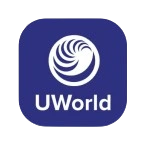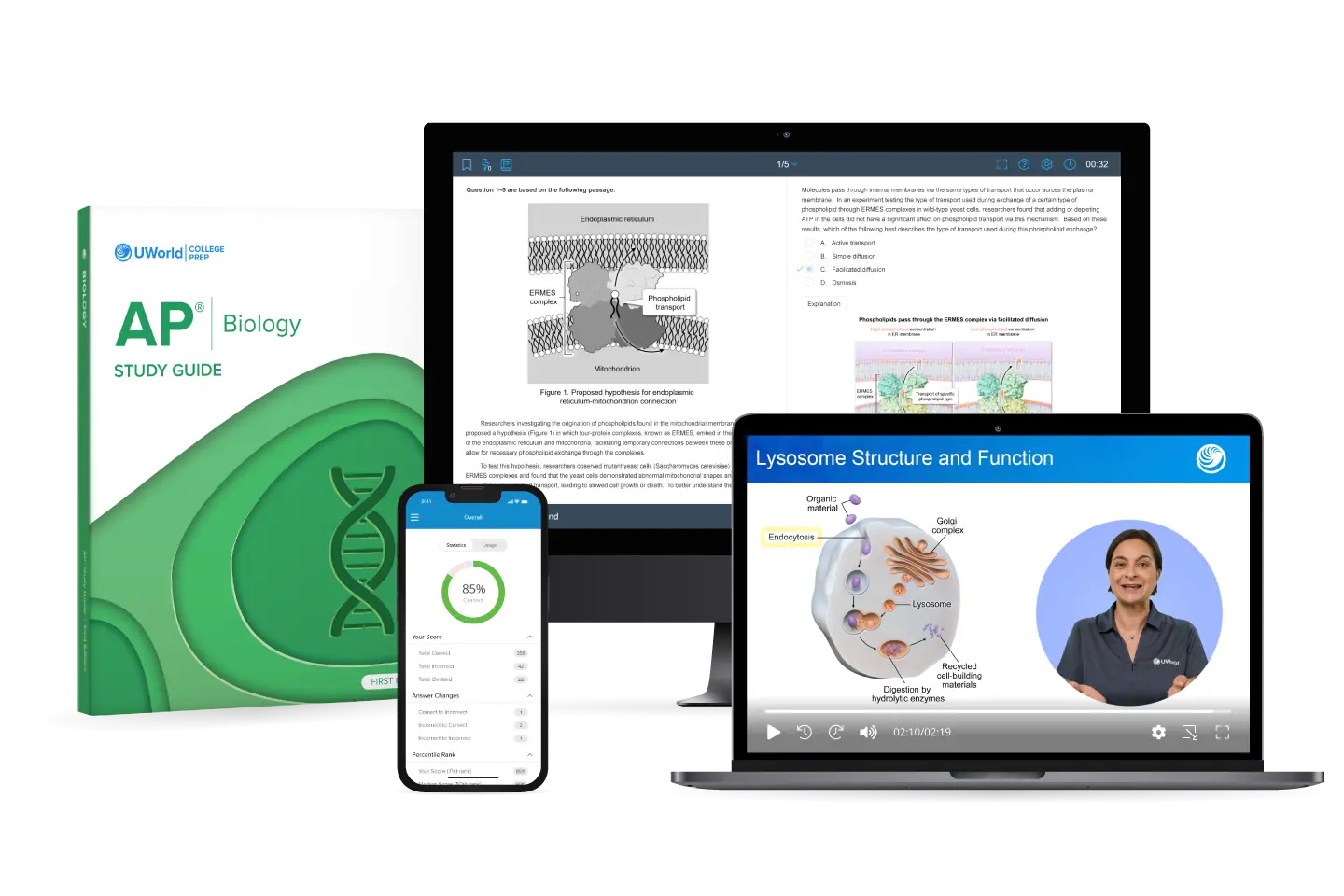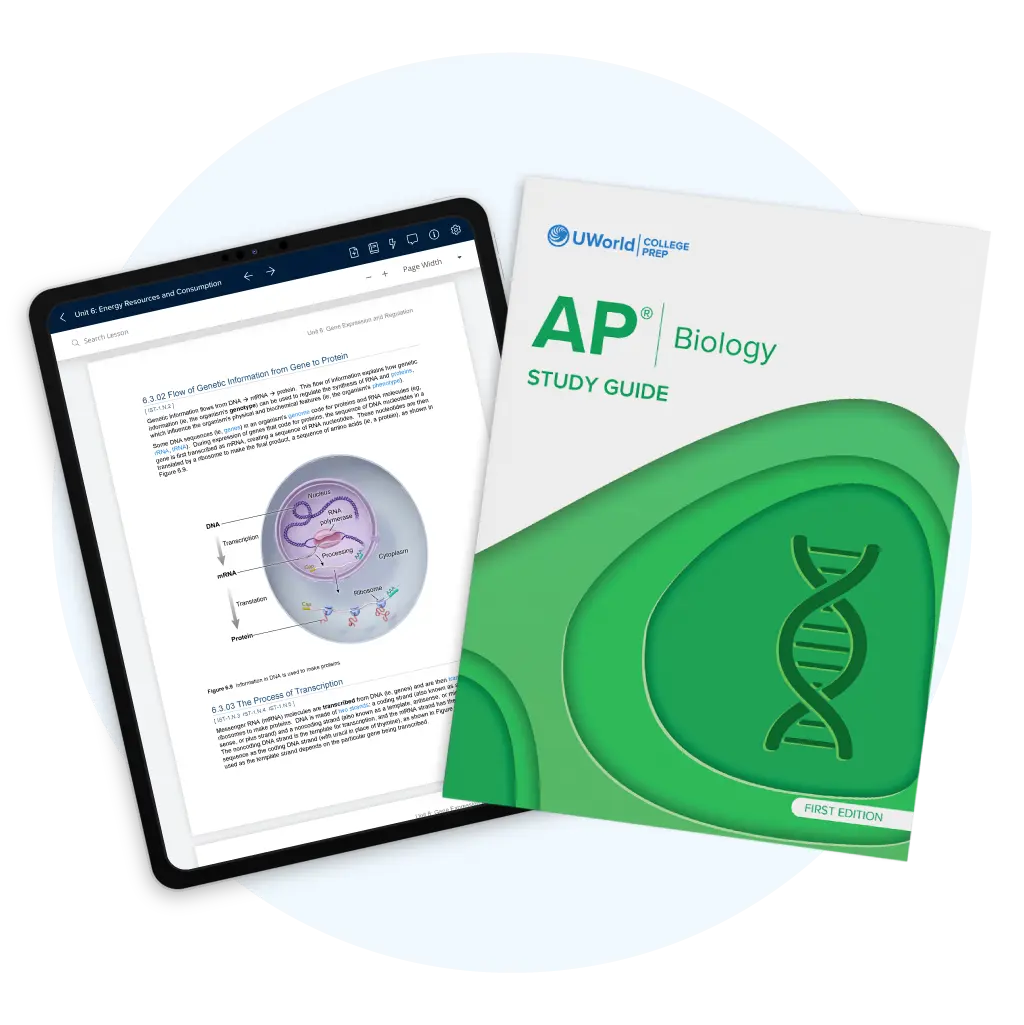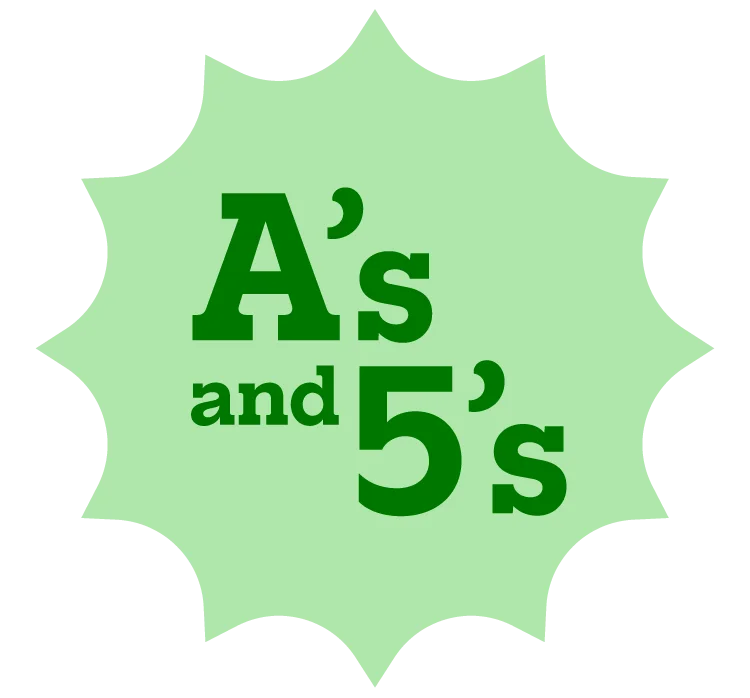AP® Biology Unit 2 Review and Practice Test
Your all-in-one solution to AP® Biology Unit 2 prep is finally here! UWorld provides comprehensive coverage of Cell Structure and Function, where AP specialists simplify topics like Cell Compartmentalization, Plasma Membrane, Tonicity and Osmoregulation, Facilitated Diffusion, and more. Not just this, you also get to test your knowledge by thoroughly practicing our AP Bio Unit 2 MCQs and FRQs, so that nothing stops you from earning a solid 5.
Boost Your Confidence and Score High with Our AP Biology Unit 2 Review
Ready to start your AP® Bio Unit 2 review? Our coursework provides you with a clear, structured learning experience to help you study smarter, not harder. Designed by subject-matter experts, our study guide, question bank, video lessons, and study tools altogether ensure that you understand even the toughest concepts with ease and achieve your desired results.
Engaging Video Lessons
Avoid the confusion of text-heavy explanations with UWorld’s short, focused, and image-rich video lessons. Our teachers break down each AP Bio Unit 2 topic into easy-to-digest segments, helping you learn faster, understand better, and retain concepts longer.
Interactive Study Guides
Our study guide is fully aligned with the College Board® CED to provide you with the most relevant content. Each AP Bio Unit 2 topic comes with step-by-step explanations, well-labelled diagrams, and check points to help you reinforce what you learn.
Try These AP Biology Unit 2 Practice Test Questions
Question
Which of the following is true regarding cell membrane structure?
| A. Proteins embedded into cell membranes have a hydrophilic membrane portion as well as hydrophobic extracellular and cytosolic portions. | |
| B. Membrane components are fixed in place and do not make lateral movements within the phospholipid bilayer. | |
| C. In addition to the phospholipids that make up the bilayer, the cell membrane contains other lipids such as glycolipids and steroids. | |
| D. In the fluid mosaic model, the nonlipid components of the cell membrane act as a fluid within which the phospholipids float. |
Explanation
Cell membranes (also known as plasma membranes) are made of a phospholipid bilayer that contains proteins (eg, glycoproteins) and other lipids (eg, glycolipids, steroids such as cholesterol).
Question
Mechanisms of cell membrane transport that require cellular energy include which of the following?
- Active transport
- Exocytosis
- Facilitated diffusion
- Simple diffusion
| A. I and II | |
| B. II and IV | |
| C. I, III, and IV | |
| D. I, II, and III |
Explanation
Active transport moves materials (eg, ions) from areas of lower concentration to areas of higher concentration. Because solutes do not naturally move against their concentration gradients in this way, active transport requires cellular energy (eg, hydrolysis of ATP). Exocytosis, a type of active transport, requires energy to move vesicles (ie, membrane-bound sacs) containing macromolecules to the cell membrane and outside of the cell.
Question
By which of the following mechanisms is water transported across the cell membrane?
| A. Endocytosis and exocytosis | |
| B. Active transport and endocytosis | |
| C. Facilitated diffusion and active transport | |
| D. Simple diffusion and facilitated diffusion |
Explanation
Passive transport, the movement of molecules down their concentration gradient without the use of cellular energy, includes simple and facilitated diffusion. Osmosis is a form of passive transport and involves the movement of water down its concentration gradient. Osmosis through a protein channel is a form of facilitated diffusion, and osmosis directly through the phospholipid bilayer is a form of simple diffusion.

Study Anywhere, Anytime
Answer practice questions on your ride home after the game, watch quick topic videos between classes, or review study guides while waiting for friends at the coffee shop. With the UWorld app, everything you need for your AP Biology Unit 2 review is always within reach. Download the mobile app today!
Stand Out
with a Top Score in AP Biology
Finish your Unit 2 AP Biology review and continue mastering all units with UWorld. Boost your performance and set yourself apart as a strong candidate for competitive colleges, majors, and scholarships by earning a top score.
Get our all-in-one course today!
- Focused AP Bio Videos
- Print & Digital Study Guide
- 500+ Exam-style Practice Questions
- Customizable Quiz Generator
- Adjustable Study Planner
- Realistic Timed Test Simulation
- Colorful Visual Explanations
- Progress Dashboard
- Smart Flashcards & Digital Notebook
Hear From Our AP Students

UWorld’s service is pretty good and helps provide a lot of explanations on subjects I haven’t been confident on before.

The questions here are the most realistic to the AP tests I've seen so far! I appreciate the ability to customize tests as well.

The best part is that all options are well-explained, telling clearly why they are not the right option.
Frequently Asked Questions (FAQs)
What does AP Biology Unit 2 cover, and why is it important?
AP Biology Unit 2 lays the groundwork for understanding how cells function and interact. It explores how cells maintain internal stability, regulate transport, and manage energy flow; core ideas that later expand into topics like metabolism, enzyme activity, and cell communication. Without a firm grasp of these concepts, students often find it difficult to interpret experimental data or explain results involving membranes and organelles, both of which are central to Unit 2 questions.
Recognizing how mitochondria and chloroplasts compartmentalize reactions also reveals how cells generate and use energy efficiently, linking structure to function. Since roughly 10 percent of the AP Biology Exam tests these principles, mastering Unit 2 directly strengthens overall exam performance.
UWorld’s AP Biology resources build this understanding seamlessly. Each lesson and practice question connects cellular structure, energy flow, and regulation in a way that reinforces both conceptual clarity and test readiness.
How can I effectively review and study AP Bio Unit 2 (Cell Structure and Function)?
Use a structured plan that moves from understanding to application. Start by summarizing key topics such as membrane structure, diffusion, facilitated diffusion, osmosis, active transport, and cell compartmentalization into your own words. Create concept maps linking organelles to their functions. Draw diagrams of prokaryotic and eukaryotic cells and label components like the nucleus, mitochondria, rough and smooth endoplasmic reticulum, Golgi apparatus, and cytoskeleton. Review core definitions using spaced repetition, especially for terms such as tonicity, water potential, and membrane permeability. Building your own AP Bio Unit 2 study guide helps organize information into digestible sections.
Then transition to active practice with AP Bio Unit 2 practice test materials. Mix question formats: multiple choice for quick recall and free response for deeper explanation. Identify weak spots and revisit them through targeted mini quizzes. Regularly explain concepts aloud or in writing without notes; this retrieval practice strengthens memory. Many learners benefit from balanced study schedules that allocate more time to challenging topics while periodically revisiting easier ones to maintain recall.
UWorld’s Read-Watch-Practice learning flow makes Unit 2 AP Bio review efficient and effective. Start by reading our comprehensive study guide chapters on each topic, then watch video lessons, and finally, practice with our extensive question bank targeting each concept.
Where can I find reliable AP Bio Unit 2 practice tests, exams, and worksheets?
Finding high-quality AP Bio Unit 2 practice tests is crucial for exam preparation. The College Board offers official practice questions, but they’re limited in quantity and don’t always provide comprehensive explanations. UWorld provides a complete AP Biology Unit 2 practice test solution with hundreds of exam-level questions covering all topics from cell structure to membrane transport. Our full-length practice tests simulate actual AP exam conditions, while custom quizzes let you focus on specific Unit 2 concepts needing improvement.
Each AP Bio Unit 2 practice question includes detailed explanations with illustrations showing exactly why each answer is correct or incorrect. Access practice tests on any device, review performance analytics showing your strengths and weaknesses, and track improvement over time. Our AP Biology prep book (available on Amazon and our website) includes additional practice problems, and our video lessons walk through complex question types step-by-step.
What are the most common FRQ topics for AP Bio Unit 2, and how should I approach them?
Free-response questions usually ask you to apply Unit 2 concepts to unfamiliar scenarios. These AP Biology Unit 2 FRQ prompts often explore:
- Membrane transport and tonicity: Predict water movement across membranes, interpret results of osmosis experiments, and explain how facilitated diffusion differs from active transport.
- Organelle identification and function: Recognize structures in micrographs such as mitochondria, chloroplasts, rough and smooth endoplasmic reticulum, and Golgi apparatus, and explain their roles.
- Experimental design: Analyze data on membrane permeability or cell size and propose controlled experiments.
When answering, restate the question in your own words, organize responses in numbered or labeled sections, and support statements with specific biological vocabulary. Practice writing concise explanations; for example, “sodium ions move through carrier proteins using ATP” shows an understanding of active transport. Annotate diagrams to illustrate the direction of diffusion or organelle interactions. Self-score practice FRQs using official rubrics to understand how points are awarded. Searching for AP Biology FRQ Unit 2 or AP Bio Unit 2 FRQ sample prompts can provide additional practice. Some learners find that UWorld’s sample FRQs and scoring guidance help them refine their written responses.
How can I improve my performance on Unit 2 multiple-choice questions (MCQs)?
Multiple choice success blends content mastery with strategy. Since Section I of the AP Biology exam contains sixty questions in ninety minutes, time management is critical. Begin by ensuring you understand cell membrane structure, organelle functions, and transport mechanisms. Then practice interpreting diagrams and graphs; many AP Bio Unit 2 MCQ questions include electron micrographs or concentration gradient plots.
Key tactics include:
- Read each question carefully and note qualifiers such as “except” or “not.”
- Eliminate clearly wrong options before choosing an answer.
- Approximate one minute per question; if you get stuck, mark it and return later.
- Practice under timed conditions to build pacing.
By working through a variety of question types, you will recognize common distractors and become comfortable with data-rich questions. If you prefer paper practice, search for AP Biology Unit 2 multiple-choice PDF sets or AP Bio Unit 2 test PDF collections. UWorld’s timed quizzes simulate exam conditions and provide detailed rationales; some students prefer mixing these with paper-based practice.
What distinctions between prokaryotic and eukaryotic cells should I know for Unit 2?
AP Biology Unit 2 compares simple prokaryotic cells with more complex eukaryotic cells. Prokaryotes, bacteria and archaea, lack a membrane-bound nucleus; their genetic material is a circular DNA molecule located in the nucleoid region. They also lack membrane-bound organelles and are typically small (about one to five micrometers). Many have a sturdy cell wall that protects against environmental stress.
Eukaryotic cells, found in animals, plants, fungi, and protists, contain a true nucleus enclosed by a nuclear envelope and an array of organelles like endoplasmic reticulum, Golgi apparatus, mitochondria, and chloroplasts. They are larger (ten to one hundred micrometers) and use compartmentalization to carry out specialized functions simultaneously. Understanding these differences helps you tackle AP biology Unit 2 cell structure and function questions and quickly distinguish cell types in diagrams. Creating side-by-side comparison charts can be a helpful study tool.
With UWorld’s Study Guide, you get a comprehensive approach to understanding prokaryotic and eukaryotic cells, utilizing side-by-side comparison tables, illustrations, and video lessons with split-screen animations to highlight their structural and functional differences. Furthermore, for exam preparation, the question bank features various comparison questions with detailed explanations, and flashcards are available for quick recall of key distinctions.
How should I study membrane transport and homeostasis for Unit 2 questions?
The plasma membrane creates a barrier that regulates what enters and exits the cell. To prepare for Unit 2 cell structure and function test questions, break transport into two broad categories:
- Passive transport uses no energy. Simple diffusion allows small nonpolar molecules like oxygen and carbon dioxide to move down their concentration gradients. Facilitated diffusion employs specific proteins to move ions or polar molecules down their gradients. Osmosis is the diffusion of water across membranes from regions of low solute concentration to high solute concentration; understanding hypertonic, hypotonic, and isotonic conditions is key for tonicity and osmoregulation questions.
- Active transport consumes ATP to move substances against their gradients. Protein pumps create electrochemical gradients, and bulk transport processes like endocytosis and exocytosis move large particles or volumes of fluid.
Learning how these processes work helps you predict changes in cell volume, pH, and ion balance. Practicing calculations of water potential and analyzing scenarios with different solution concentrations will prepare you for both multiple-choice and free-response items. Visual aids, whether diagrams in textbooks or animated models, can make it easier to picture molecules moving across the membrane.
What should I look for when analyzing cell diagrams on Unit 2 assessments?
Cell diagram analysis is crucial for AP Biology Unit 2 test success, appearing in both MCQ and FRQ sections.
Identification Strategies
1. Recognize Key Features:
- Mitochondria: Double membrane, cristae (inner membrane folds), matrix
- Chloroplasts: Double membrane, thylakoids stacked into grana, stroma
- Rough ER: Studded with ribosomes, flattened sacs
- Smooth ER: No ribosomes, tubular network
- Golgi apparatus: Stacked, flattened membrane sacs (cisternae)
- Nucleus: Double membrane (nuclear envelope), nucleolus visible inside
2. Prokaryotic vs. Eukaryotic Recognition: Look for a membrane-bound nucleus and organelles (eukaryotic) or lack thereof (prokaryotic).
3. Plant vs. Animal Cells: Cell wall, large central vacuole, and chloroplasts indicate plant cells.
4. Functional Analysis: Don’t just identify structures—understand their functions. If a question shows cells with many mitochondria, recognize high energy demands. Numerous ribosomes suggest active protein synthesis.
5. Scale Awareness: Use scale bars to determine cell/organelle size. This helps identify structures and understand cellular limitations.
6. Membrane Analysis: Identify plasma membrane structure, recognize embedded proteins, and understand membrane protein functions shown in diagrams.
UWorld’s study guide includes high-quality electron micrographs with detailed labeling and identification tips throughout Unit 2 chapters. Our video lessons walk through systematic approaches for analyzing unfamiliar cell diagrams, teaching you what to look for first.
How do FRQs and MCQs differ in assessing Unit 2 material?
The AP Biology exam balances multiple-choice and free-response sections, each testing distinct skills.
Multiple-choice items assess breadth. They may present diagrams, graphs, or short paragraphs and ask you to recall or apply facts about cell structure, membrane transport, osmosis, and tonicity. Each question has one correct answer, so there is no partial credit. To prepare for AP Bio Unit 2 MCQ tasks, practice recognizing distractors, interpreting diagrams, and managing your time.
Free response questions probe depth. Long prompts require designing experiments or interpreting data, while short prompts may ask for data analysis, conceptual explanations, or model interpretation. Partial credit is awarded for correct elements even if the entire response is not complete. To prepare for AP Bio Unit 2 FRQ sections, practice writing structured answers using precise vocabulary and reasoning through your explanations.
A strong Unit 2 AP Bio review should incorporate both styles. Work through timed multiple-choice sets to build speed and accuracy, and tackle free-response prompts to practice structuring your thoughts and justifying your conclusions. Combining these approaches will help you feel confident on exam day. Alternating between quick recall exercises and longer written explanations builds flexibility, and UWorld’s blended practice resources support both formats within a single program.





